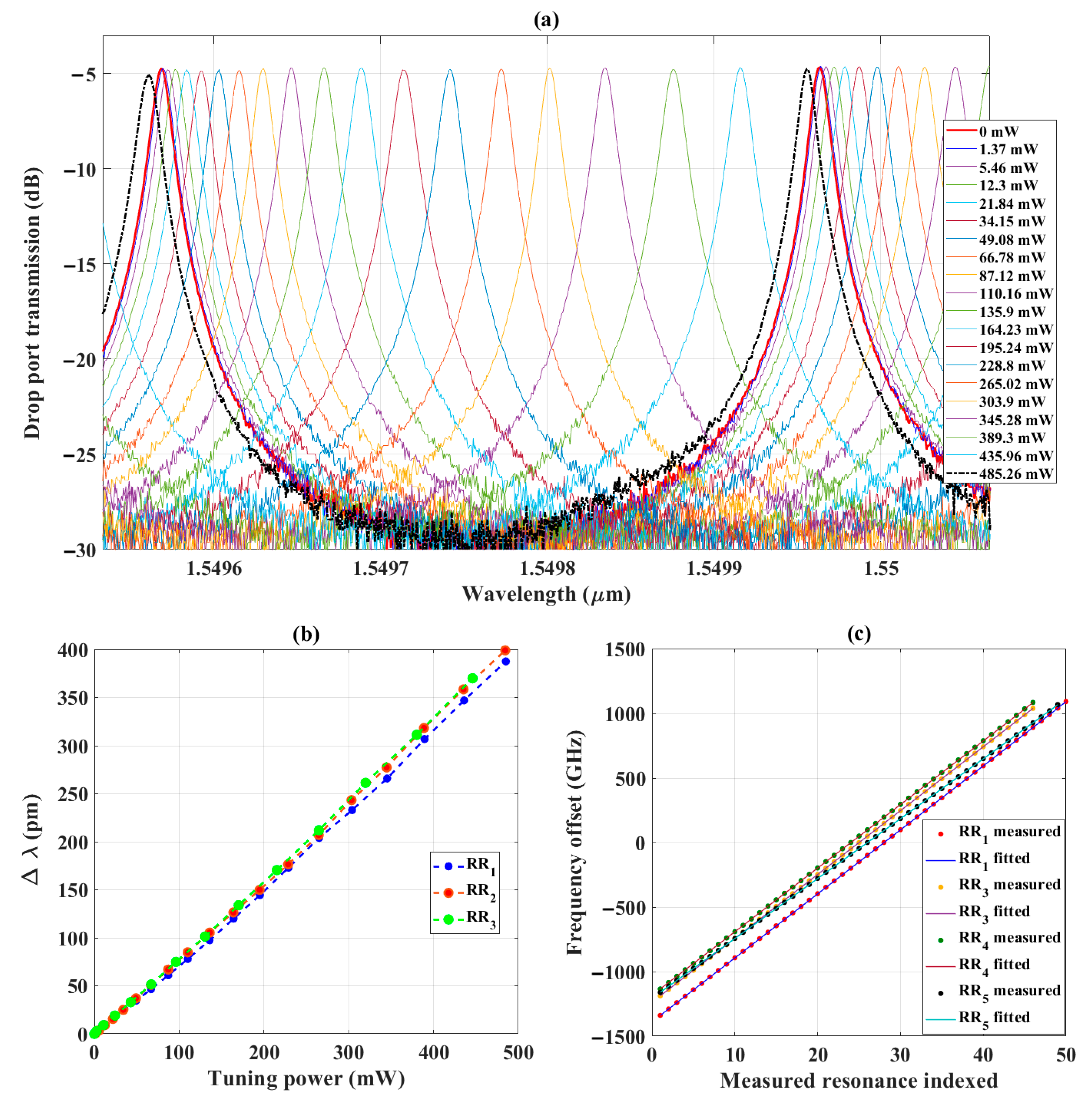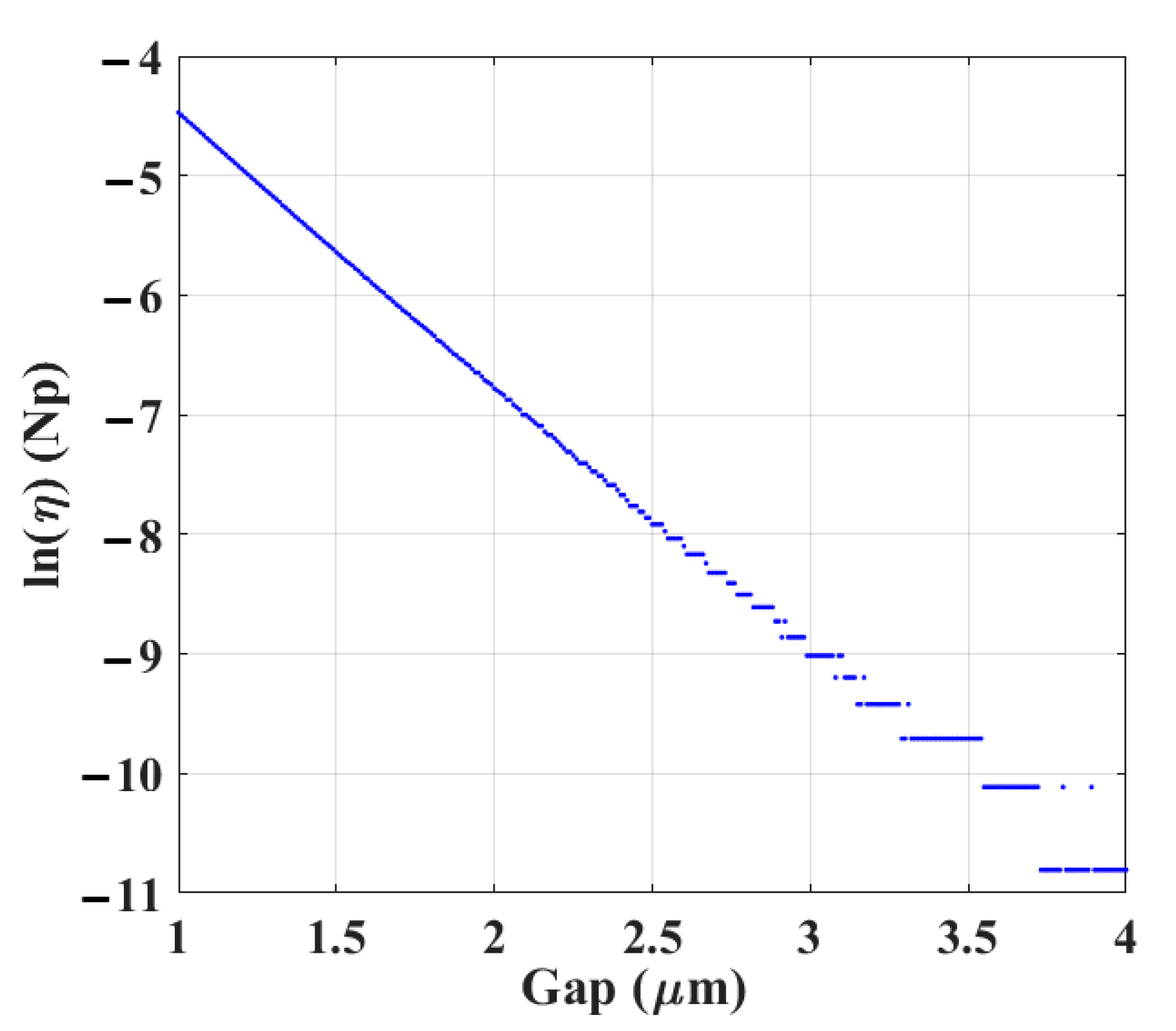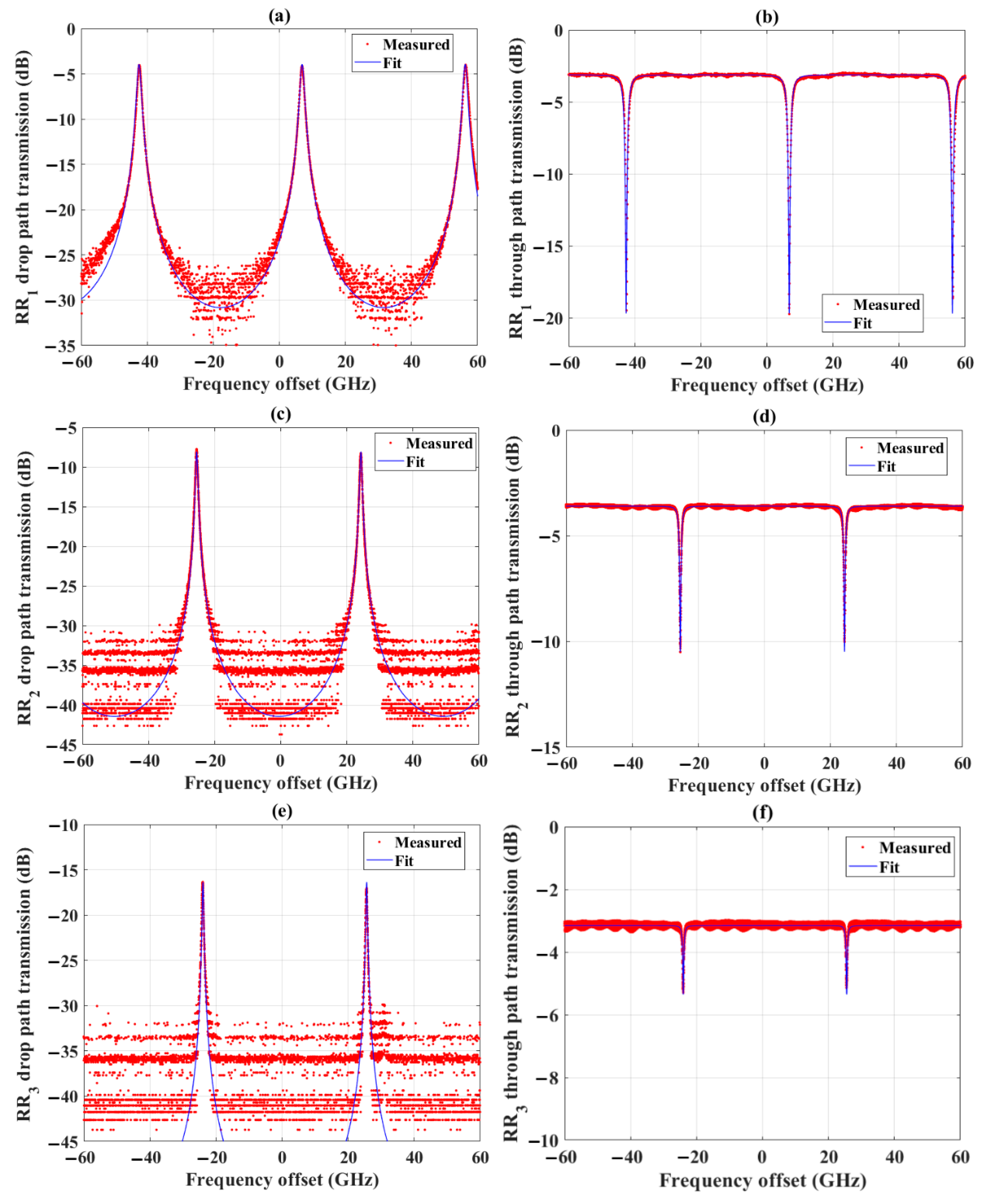Ring Resonator Gap Determination Design Rule and Parameter Extraction Method for Sub-GHz Resolution Whole C-Band Si3N4 Integrated Spectrometer
Abstract
:1. Introduction
2. Theory
2.1. Parameter Extraction Method
2.2. Dependence of Ring Resonator Coupling Coefficients on Gap
2.3. Quality Factor and Finesse
3. Fabrication and Experimental Setup
4. Discussion
- The effective index split of the two lowest-order local modes is found using a mode solver. The accuracy may be improved by increasing the number of local modes in the interaction;
- The difference data may be fitted to a suitable curve by a curve fitting toolbox. For an adiabatic curved coupler, the dependence of the effective index difference as a function of z is certainly a smooth bell-shaped curve, as in (21);
- The fitting will aid its numerical integration. If the asymptotic tails decay exponentially, it will allow an analytic integration of the tail region for . This will predict the overall power transfer matrix of the couplers based on proximate curved waveguides.
5. Conclusions
Author Contributions
Funding
Institutional Review Board Statement
Informed Consent Statement
Data Availability Statement
Acknowledgments
Conflicts of Interest
References
- Bogaerts, W.; Dumon, P.; Thourhout, D.V.; Taillaert, D.; Jaenen, P.; Wouters, J.; Beckx, S.; Wiaux, V.; Baets, R.G. Compact wavelength-selective functions in silicon-on-insulator photonic wires. IEEE J. Sel. Top. Quantum Electron. 2006, 12, 1394–1401. [Google Scholar] [CrossRef]
- Antonacci, G.; Elsayad, K.; Polli, D. On-Chip Notch Filter on a Silicon Nitride Ring Resonator for Brillouin Spectroscopy. ACS Photonics 2022, 9, 772–777. [Google Scholar] [CrossRef]
- Xia, F.; Sekaric, L.; Vlasov, Y. Ultracompact optical buffers on a silicon chip. Nat. Photonics 2007, 1, 65–71. [Google Scholar] [CrossRef]
- Ibrahim, T.; Grover, A.R.; Kuo, L.C.; Kanakaraju, S.; Calhoun, L.C.; Ho, P.T. All-optical AND/NAND logic gates using semiconductor microresonators. IEEE Photon. Technol. 2003, 15, 1422–1424. [Google Scholar] [CrossRef]
- Ji, R.; Yang, L.; Zhang, L.; Tian, Y.; Ding, J.; Chen, H.; Lu, Y.; Zhou, P.; Zhu, W. Microring-resonator-based four-port optical router for photonic networks-on-chip. Opt. Express 2011, 19, 18945–18955. [Google Scholar] [CrossRef]
- Fan, X.; White, I.M.; Zhu, H.; Suter, J.D.; Oveys, H. Overview of novel integrated optical ring resonator bio/chemical sensors. In Proceedings of the SPIE Laser Resonators Beam Control IX, San Jose, CA, USA, 14 February 2007. [Google Scholar]
- Xu, Q.; Manipatruni, S.; Schmidt, B.; Shakya, J.; Lipson, M. 12.5 Gbit/s carrier-injection-based silicon micro-ring silicon modulators. Opt. Express 2007, 15, 430–436. [Google Scholar] [CrossRef]
- Jin, W.; Yang, Q.F.; Chang, L.; Shen, B.; Wang, H.; Leal, M.A.; Wu, L.; Gao, M.; Feshali, A.; Paniccia, M.; et al. Hertz-linewidth semiconductor lasers using CMOS-ready ultra-high-Q microresonators. Nat. Photonics 2021, 15, 346–353. [Google Scholar] [CrossRef]
- Ye, Z.; Twayana, K.; Andrekson, P.A. High-Q Si3N4 microresonators based on a subtractive processing for Kerr nonlinear optics. Opt. Express 2019, 27, 35719–35727. [Google Scholar] [CrossRef]
- Bogaerts, W.; Heyn, P.D.; Vaerenbergh, T.V.; Vos, K.D.; Selvaraja, S.K.; Claes, T.; Dumon, P.; Bienstman, P.; Thourhout, D.V.; Baets, R. Silicon microring resonators. Laser Photonics Rev. 2012, 6, 47–73. [Google Scholar] [CrossRef]
- Mahmoud, M.; Cai, L.; Bottenfield, C.; Piazza, G. Lithium niobate electro-optic racetrack modulator etched in Y-cut LNOI platform. IEEE Photon. J. 2018, 10, 1–10. [Google Scholar] [CrossRef]
- Chen, L.; Wood, M.G.; Reano, R.M. 12.5 pm/V hybrid silicon and lithium niobate optical microring resonator with integrated electrodes. Opt. Express 2013, 21, 27003–27010. [Google Scholar] [CrossRef] [PubMed]
- Ahmed, A.N.R.; Shi, S.; Zablocki, M.; Yao, P.; Prather, D.W. Tunable hybrid silicon nitride and thin-film lithium niobate electro-optic microresonator. Opt. Lett. 2019, 44, 618–621. [Google Scholar] [CrossRef] [PubMed]
- Grover, R.; Absil, P.P.; Van, V.; Hryniewicz, J.V.; Little, B.E.; King, O.; Calhoun, L.C.; Johnson, F.G.; Ho, P.T. Vertically coupled GaInAsP–InP microring resonators. Opt. Lett. 2001, 26, 506–508. [Google Scholar] [CrossRef] [PubMed]
- Ibrahim, T.A.; Van, V.; Ho, P.T. All-optical time-division demultiplexing and spatial pulse routing with a GaAs/AlGaAs microring resonator. Opt. Lett. 2002, 27, 803–805. [Google Scholar] [CrossRef] [PubMed]
- Bogaerts, W.; Bienstman, P.; Baets, R. Scattering at sidewall roughness in photonic crystal slabs. Opt. Lett. 2003, 28, 689–691. [Google Scholar] [CrossRef]
- Spencer, D.T.; Bauters, J.F.; Heck, M.J.; Bowers, J.E. Integrated waveguide coupled Si3N4 resonators in the ultrahigh-Q regime. Optica 2014, 1, 153–157. [Google Scholar] [CrossRef]
- Puckett, M.W.; Liu, K.; Chauhan, N.; Zhao, Q.; Jin, N.; Cheng, H.; Wu, J.; Behunin, R.O.; Rakich, P.T.; Nelson, K.D.; et al. 422 Million intrinsic quality factor planar integrated all-waveguide resonator with sub-MHz linewidth. Nat. Commun. 2021, 12, 1–8. [Google Scholar]
- Liu, K.; Jin, N.; Cheng, H.; Chauhan, N.; Puckett, M.W.; Nelson, K.D.; Behunin, R.O.; Rakich, P.T.; Blumenthal, D.J. Ultralow 0.034 dB/m loss wafer-scale integrated photonics realizing 720 million Q and 380 μW threshold Brillouin lasing. Opt. Lett. 2022, 47, 1855–1858. [Google Scholar] [CrossRef]
- Ciminelli, C.; Innone, F.; Brunetti, G.; Conteduca, D.; Dell’Olio, F.; Tatoli, T.; Armenise, M.N. Rigorous model for the design of ultra-high Q-factor resonant cavities. In Proceedings of the 18th International Conference on Transparent Optical Networks (ICTON), Trento, Italy, 10–14 July 2016. [Google Scholar]
- Lu, X.; McClung, A.; Srinivasan, K. High-Q slow light and its localization in a photonic crystal microring. Nat. Photonics 2022, 16, 66–71. [Google Scholar] [CrossRef]
- Kyotoku, B.B.; Chen, L.; Lipson, M. Sub-nm resolution cavity enhanced micro-spectrometer. Opt. Express 2010, 18, 102–107. [Google Scholar] [CrossRef]
- Yurtsever, G.; Baets, R. Integrated spectrometer on silicon on insulator. In Proceedings of the 16th Annual Symposium of the IEEE Photonics Benelux Chapter, Ghent, Belgium, 1–2 December 2011. [Google Scholar]
- Xia, Z.; Eftekhar, A.A.; Soltani, M.; Momeni, B.; Li, Q.; Chamanzar, M.; Yegnanarayanan, S.; Adibi, A. High resolution on-chip spectroscopy based on miniaturized microdonut resonators. Opt. Express 2011, 19, 12356–12364. [Google Scholar] [CrossRef] [PubMed]
- Xiang, C.; Morton, P.A.; Khurgin, J.; Morton, C.; Bowers, J.E. Widely tunable Si3N4 triple-ring and quad-ring resonator laser reflectors and filters. In Proceedings of the 2018 IEEE 15th International Conference on Group IV Photonics (GFP), Cancun, Mexico, 29–31 August 2018. [Google Scholar]
- Zheng, S.; Cai, H.; Song, J.; Zou, J.; Liu, P.Y.; Lin, Z.; Kwong, D.-L.; Liu, A.-Q. A Single-Chip Integrated Spectrometer via Tunable Microring Resonator Array. IEEE Photon. J. 2019, 11, 1–9. [Google Scholar] [CrossRef]
- Zheng, S.N.; Zou, J.; Cai, H.; Song, J.F.; Chin, L.K.; Liu, P.Y.; Lin, Z.P.; Kwong, D.L.; Liu, A.Q. Microring resonator-assisted Fourier transform spectrometer with enhanced resolution and large bandwidth in single chip solution. Nat. Commun. 2019, 10, 1–8. [Google Scholar] [CrossRef] [PubMed]
- Li, Y.; Li, J.; Yu, H.; Yu, H.; Chen, H.; Yang, S.; Chen, M. On-chip photonic microsystem for optical signal processing based on silicon and silicon nitride platforms. Adv. Opt. Technol. 2018, 7, 81–101. [Google Scholar] [CrossRef]
- Kita, D.M.; Lin, H.; Agarwal, A.; Richardson, K.; Luzinov, I.; Gu, T.; Hu, J. On-chip infrared spectroscopic sensing: Redefining the benefits of scaling. IEEE J. Sel. Top. Quantum Electron. 2016, 23, 340–349. [Google Scholar] [CrossRef]
- Hasan, M.; Rad, M.; Hasan, G.M.; Liu, P.; Dumais, P.; Bernier, E.; Hall, T.J. Ultra-high resolution wideband On-chip spectrometer. IEEE Photon. J. 2020, 12, 1–17. [Google Scholar] [CrossRef]
- Hasan, M.; Hasan, G.M.; Ghorbani, H.; Rad, M.; Liu, P.; Bernier, E.; Hall, T. Circuit design and integration feasibility of a high-resolution broadband on-chip spectral monitor. arXiv 2021, arXiv:2108.10121. [Google Scholar]
- Zhuang, L.; Marpaung, D.; Burla, M.; Beeker, W.; Leinse, A.; Roeloffzen, C. Low-loss, high-index-contrast Si3N4/SiO2 optical waveguides for optical delay lines in microwave photonics signal processing. Opt. Express 2011, 19, 23162–23170. [Google Scholar] [CrossRef]
- Yariv, A. Universal relations for coupling of optical power between microresonators and dielectric waveguides. Electron. Lett. 2000, 36, 321–322. [Google Scholar] [CrossRef]
- Gifford, D.K.; Soller, B.J.; Wolfe, M.S.; Froggatt, M.E. Optical vector network analyzer for single-scan measurements of loss, group delay, and polarization mode dispersion. Appl. Opt. 2005, 44, 7282–7286. [Google Scholar] [CrossRef]
- Heebner, J.E.; Wong, V.; Schweinsberg, A.; Boyd, R.W.; Jackson, D.J. Optical transmission characteristics of fiber ring resonators. IEEE J. Quantum Electron. 2004, 40, 726–730. [Google Scholar] [CrossRef]
- Matres, J.; Ballesteros, G.C.; Mas, S.; Brimont, A.; Sanchis, P.; Marti, J.; Oton, C.J. Optical phase characterization of photonic integrated devices. IEEE J. Sel. Top. Quantum Electron. 2013, 20, 417–421. [Google Scholar] [CrossRef]
- McKinnon, W.R.; Xu, D.-X.; Storey, C.; Post, E.; Densmore, A.; Delâge, A.; Waldron, P.; Schmid, J.H.; Janz, S. Extracting coupling and loss coefficients from a ring resonator. Opt. Express 2009, 17, 18971–18982. [Google Scholar] [CrossRef] [PubMed]
- Roeloffzen, C.G.H.; Hoekman, M.; Klein, E.J.; Wevers, L.S.; Timens, R.B.; Marchenko, D.; Geskus, D.; Dekker, R.; Alippi, A.; Grootjans, R.; et al. Low-loss Si3N4 TriPleX optical waveguides: Technology and applications overview. IEEE J. Sel. Top. Quantum Electron. 2018, 24, 1–21. [Google Scholar] [CrossRef] [Green Version]







| Gap (μm) | FWHM Bandwidth (GHz) | FSR (GHz) | Cross-Power Coupling Ratio (%) | Ring Transmission Loss (dB) | Quality Factor, Q | |
|---|---|---|---|---|---|---|
| RR1 | 1.2 | ~1.43 | ~49.4 | 7.46 | 0.12 | 135,258 |
| RR2 | 1.5 | ~0.68 | ~49.7 | 2.33 | 0.17 | 284,469 |
| RR3 | 1.8 | ~0.45 | ~49.55 | 0.64 | 0.19 | 429,867 |
| RR4 | 1.8 | ~0.55 | ~49.8 | 0.68 | 0.24 | 351,671 |
| RR5 | 2.0 | ~0.35 | ~46.55 | 0.29 | 0.18 | 552,640 |
Publisher’s Note: MDPI stays neutral with regard to jurisdictional claims in published maps and institutional affiliations. |
© 2022 by the authors. Licensee MDPI, Basel, Switzerland. This article is an open access article distributed under the terms and conditions of the Creative Commons Attribution (CC BY) license (https://creativecommons.org/licenses/by/4.0/).
Share and Cite
Hasan, G.M.; Liu, P.; Hasan, M.; Ghorbani, H.; Rad, M.; Bernier, E.; Hall, T.J. Ring Resonator Gap Determination Design Rule and Parameter Extraction Method for Sub-GHz Resolution Whole C-Band Si3N4 Integrated Spectrometer. Photonics 2022, 9, 651. https://doi.org/10.3390/photonics9090651
Hasan GM, Liu P, Hasan M, Ghorbani H, Rad M, Bernier E, Hall TJ. Ring Resonator Gap Determination Design Rule and Parameter Extraction Method for Sub-GHz Resolution Whole C-Band Si3N4 Integrated Spectrometer. Photonics. 2022; 9(9):651. https://doi.org/10.3390/photonics9090651
Chicago/Turabian StyleHasan, Gazi Mahamud, Peng Liu, Mehedi Hasan, Houman Ghorbani, Mohammad Rad, Eric Bernier, and Trevor J. Hall. 2022. "Ring Resonator Gap Determination Design Rule and Parameter Extraction Method for Sub-GHz Resolution Whole C-Band Si3N4 Integrated Spectrometer" Photonics 9, no. 9: 651. https://doi.org/10.3390/photonics9090651





